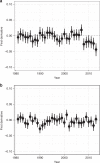Widespread losses of pollinating insects in Britain
- PMID: 30914632
- PMCID: PMC6435717
- DOI: 10.1038/s41467-019-08974-9
Widespread losses of pollinating insects in Britain
Abstract
Pollination is a critical ecosystem service underpinning the productivity of agricultural systems across the world. Wild insect populations provide a substantial contribution to the productivity of many crops and seed set of wild flowers. However, large-scale evidence on species-specific trends among wild pollinators are lacking. Here we show substantial inter-specific variation in pollinator trends, based on occupancy models for 353 wild bee and hoverfly species in Great Britain between 1980 and 2013. Furthermore, we estimate a net loss of over 2.7 million occupied 1 km2 grid cells across all species. Declines in pollinator evenness suggest that losses were concentrated in rare species. In addition, losses linked to specific habitats were identified, with a 55% decline among species associated with uplands. This contrasts with dominant crop pollinators, which increased by 12%, potentially in response agri-environment measures. The general declines highlight a fundamental deterioration in both wider biodiversity and non-crop pollination services.
Conflict of interest statement
The authors declare no competing interests.
Figures



References
-
- Ollerton J, Winfree R, Tarrant S. How many flowering plants are pollinated by animals? Oikos. 2011;120:321–326. doi: 10.1111/j.1600-0706.2010.18644.x. - DOI
-
- Garratt MPD, et al. Pollination deficits in UK apple orchards. J. Pollinat. Ecol. 2014;12:9–14.
Publication types
MeSH terms
LinkOut - more resources
Full Text Sources

